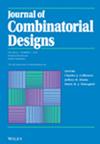关于具有旗变换群和点准三态群的对称设计
IF 0.8
4区 数学
Q3 MATHEMATICS
引用次数: 0
摘要
设 D = ( P , ℬ ) 是一个非对称对称 ( v , k , λ ) 设计,且 λ ≤ 100 。 -设计,且 λ ≤ 100 ,设 G 是 D 的旗反自变群。本文将证明,如果 G 在 P 上是类对立的,那么 G 是全形仿射型或近似简单型。此外,如果 G 在 P 上是隐含的,那么 G 几乎是简单类型的。根据这一观察和有限简单群的分类,我们确定了所有这类对称设计和相应的自变群。最后,我们提出两个悬而未决的问题和一个猜想。本文章由计算机程序翻译,如有差异,请以英文原文为准。
On symmetric designs with flag-transitive and point-quasiprimitive automorphism groups
Let be a nontrivial symmetric -design with , and let be a flag-transitive automorphism group of . In this paper, we show that if is quasiprimitive on , then is of holomorph affine or almost simple type. Moreover, if is imprimitive on , then is of almost simple type. According to this observation and to the classification of the finite simple groups we determine all such symmetric designs and the corresponding automorphism groups. We conclude with two open problems and a conjecture.
求助全文
通过发布文献求助,成功后即可免费获取论文全文。
去求助
来源期刊
CiteScore
1.60
自引率
14.30%
发文量
55
审稿时长
>12 weeks
期刊介绍:
The Journal of Combinatorial Designs is an international journal devoted to the timely publication of the most influential papers in the area of combinatorial design theory. All topics in design theory, and in which design theory has important applications, are covered, including:
block designs, t-designs, pairwise balanced designs and group divisible designs
Latin squares, quasigroups, and related algebras
computational methods in design theory
construction methods
applications in computer science, experimental design theory, and coding theory
graph decompositions, factorizations, and design-theoretic techniques in graph theory and extremal combinatorics
finite geometry and its relation with design theory.
algebraic aspects of design theory.
Researchers and scientists can depend on the Journal of Combinatorial Designs for the most recent developments in this rapidly growing field, and to provide a forum for both theoretical research and applications. All papers appearing in the Journal of Combinatorial Designs are carefully peer refereed.

 求助内容:
求助内容: 应助结果提醒方式:
应助结果提醒方式:


